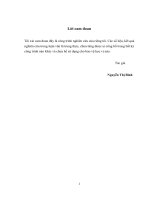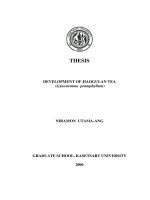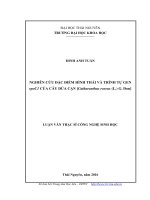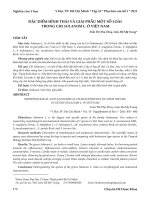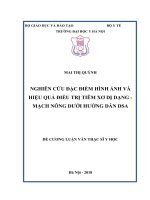đặc điểm hình thái, sinh lý, hóa sinh của cây Giảo cổ lam.
Bạn đang xem bản rút gọn của tài liệu. Xem và tải ngay bản đầy đủ của tài liệu tại đây (5.47 MB, 268 trang )
THESIS
DEVELOPMENT OF JIAOGULAN TEA
(Gynostemma pentaphyllum)
NIRAMON UTAMA-ANG
GRADUATE SCHOOL, KASETSART UNIVERSITY
2006
THESIS
DEVELOPMENT OF JIAOGULAN TEA
(Gynostemma pentaphyllum)
NIRAMON UTAMA-ANG
A Thesis Submitted in Partial Fulfillment of
the Requirements for the Degree of
Doctor of Philosophy (Agro-Industrial Product Development)
Graduate School, Kasetsart University
2006
ISBN 974-16-2559-6
First of all, I would like to express my deepest gratitude to my advisor,
Assosociate Professor Penkwan Chompreeda, and my committees, Assosociate
Professor Vichai Haruthai-thanason, Assosociate Professor Nusiri Lerdvuthissopon,
Assistant Professor Thongchai Suwonasichon and Professor Bruce A. Watkins, for
their worth guidance throughout my study. My sincere appreciation is devoted to Dr.
Y. Li, Dr. K. Wood, Dr. U. Khansuwan, Dr. Somdek, Dr. S. Nielsen, Dr. M. Ferruzzi,
Dr. P. Wiriyajaree and Dr. A. Jangchud for their warmest encouragement and helpful
suggestions.
I would like to acknowledge to The Royal Project Foundation and The Agro-
Industrial Consortium Program, The Ministry of University Affairs, Thailand, for
financial support of this research, as well as, the Dept. of Product Development,
Kasetsart University; the Dept. of Product Development Technology and the Dept. of
Biochemistry, Faculty of Medicine, Chiangmai University and the Dept. of Food
Science, Purdue University for providing research facilities.
I would also expand my special thanks to:
My friends at Kasetsart University; Tim, June, Kai, Dow, Prathurn, Waal,
Jam, Bouy, Jeab, Thee, Keaw, Pum, Pin, Fong and PD students, for supporting
together during my Ph.D. study.
My friends at Chiangmai University; Keng, Nuch, Jitra, Pongtong, Nan, Toa,
Iss, Tang and others, for their assistances.
My friends at Purdue University; Yee, Tukta, Mort, Kong, Eak, Eva, Han,
Ming, Tom, Angela , Steve, Kevin, Ben, Gorge, Kook, Win, Yui and all PUSA
members, for being my good friends when I was in U.S. during one year.
My trained panelists who participated in my sensory tests and also all
respondents who participated in my consumer tests.
Finally, my heartfelt appreciation is given to my mom, my dad, my sister,
Nud, my brother, Na and his family, for their love and carefulness. My greatest
thankfulness goes to my husband, Surachai, for everything he supports me and my
sunshine daughter, Meen, who always hearten me.
Niramon Utama-ang
July, 2006
i
TABLE OF CONTENTS
Page
TABLE OF CONTENTS i
LIST OF TABLES ii
LIST OF FIGURES v
INTRODUCTION 1
LITERATURE REVIEWS 3
Jiaogulan 3
Cholesterol and Lipoprotein 12
Antioxidant 18
Saponin 21
Technique in Product Development System 36
Drying Process 46
MATERIALS AND METHODS 54
Materials 54
Methods 55
RESULTS AND DISCUSSION 82
Phase I: Raw Material Assessment 82
Phase II: Drying Process of Jiaogulan 85
Phase III: Identification and Effect of Jiaogulan Extract in Animal
Model Study 96
Phase IV: Product development of herbal beverage from
Jiaogulan 118
CONCLUSION 185
RECOMMENDATION FOR FUTURE WORK 188
LITERATURE CITED 189
APPENDIX 218
CIRRICULUM VITAE 255
ii
LIST OF TABLES
Table Page
1 The lipoprotein properties and protein composition of normal
human plasma 17
2 The desire value, borderline and high value of human serum lipid 17
3 Mechanisms of antioxidant activity 19
4 Review of saponin research with rats and in vitro 27
5 Compositions of the diets 63
6 The pentagon design with 6 design points of Jiaogulan tea
treatments 73
7 Definition of descriptive attributes for Jiaogulan tea infusion 74
8 Reference samples for the 13 descriptive attributes of Jiaogulan
tea infusion 75
9 The yield, moisture content and total solid of Jiaogulan parts 82
10 Physical properties of dried Jiaogulan by hot air drying and
microwave vacuum drying 90
11 Chemical properties of dried Jiaogulan by microwave-vacuum
drying of two crops 95
12 Aglycones obtained from Jiaogulan extracts by alkaline cleavage 104
13 Characteristic ion of trimethylsilylated aglycones obtained from
Jiaogulan extracts 105
14 Total cholesterol level of the rats after feeding various diet
treatments 110
15 Triacylglycerol level of the rats after feeding various diet
treatments 111
16 LDL cholesterol level of the rats after feeding various diet
treatments 112
17 HDL cholesterol level of the rats after feeding various diet
treatments 113
iii
LIST OF TABLES (Continued)
Table Page
18 The mean comparisons of serum lipid after feeding various diets
by Pair Student’s t-test 114
19 Herbal beverage products in the market place in Thailand during
November to December, 2003 119
20 Attitude and behavior of consumer in herbal beverage 128
21 The demographic profile of the respondents in consumer survey 133
22 The consumer behavior on herbal beverage of the respondents 136
23 The favorite herbal beverage of respondents 137
24 Attitudes of the respondents toward herbal beverage 138
25 Factors that respondents weight for the important of the herbal
beverage 140
26 The factor loading of herbal beverage 142
27 The relation model of components by factor analysis 143
28 Mean hedonic ratings of Jiaogulan tea as rated by consumers in
different locations 144
29 Binary Logistic regression analysis of hedonic attribute rating
effect to acceptance of the respondents 144
30 Response (%) in JAR scale for the attributes of Jiaogulan tea 145
31 Mean hedonic rating by age 147
32 Cross tabulations between age and acceptance , between age and
flavor added and between age and beverage form of the
respondents 148
33 Kinetic and equilibrium data for Jiagulan tea infusion over a
temperature range 151
34 Effect of time and temperature on SEY, total saponin and
antioxidant activity in Jiaogulan tea infusion 153
35 Total saponin content and antioxidant activity of Jiaogulan tea
Infusion 156
iv
LIST OF TABLES (Continued)
Table Page
36 The regression models of chemical component of Jiaogulan tea
infusion 156
37 Sensory descriptive mean values of Jiaogulan tea infusion 159
38 The regression models of sensory descriptive attributes of
Jiaogulan tea infusion 161
39 Mean hedonic rating of Jiaogulan tea treatments by consumer 166
40 The regression models of consumer acceptance of Jiaogulan tea
infusion 166
41 Predicted values of Jiaogulan tea from regression models 170
42 Finished product quality of Jiaogulang tea 172
43 The demographic profile of the respondents in consumer test 174
44 Mean hedonic rating of Jiaogulan tea as rate by target consumers
from different locations 175
45 Percent of acceptance and buying decision by consumer 176
46 The buying decision of consumer before and after knowing the
product information 179
47 The specification of Jiaogulan tea product 182
Appendix Table
1 Mineral Mix # 210025 (Dyets Inc., Bethlehem, PA., U.S.A.) 221
2 Vitamin Mix # 310025 (Dyets Inc., Bethlehem, PA, U.S.A.) 222
v
LIST OF FIGURES
Figure Page
1 Jiaogulan plant (Gynostermma pentaphyllum) 3
2 The structure of dammarane-type aglycones of gypenosides from
Jiaogulan 5
3 Cholesterol molecule 13
4 Composition of lipoproteins 15
5 The exogenous and endogenous pathway for lipoprotein and
triglyceride 16
6 Classification of saponin 22
7 Basic structure of sapogenins: a steroid (a) and a triterpenoid (b) 23
8 Convective, vacuum and microwave drying of chlorpropamide 51
9 Typical applications of microwave energy 52
10 Microwave-vacuum drying versus air and freeze-drying 53
11 Identification of Jiaogulan extracts 61
12 Experiment design for animal model study 63
13 Jiaogulan tea process 70
14 The trolox equivalent antioxidant capacity of leaf and stem of
fresh Jiaogulan 84
15 The total saponin in leaf and stem of fresh Jiaogulan 85
16 Drying curve of Jiaogulan by tray drying with different
temperatures 86
17 Drying rate of Jiaogulan dried by tray drier 87
18 Drying curve of Jiaogulan dried by vacuum microwave drier with
different microwave power levels 88
19 Drying rate of Jiaogulan dried by vacuum microwave 89
20 Total saponin in dried Jiaogulan using hot air drying and vacuum-
microwave drying 92
21 The trolox eqivaent of antioxidant capacity of dried Jiaogulan using
hot air drying and vacuum-microwave drying 94
vi
LIST OF FIGURES (Continued)
Figure Page
22 GC-MS ion chromatogram of Jiaogulan water extract 97
23 GC-MS ion chromatogram of Jiaogulan methanol extract 97
24 GC-MS ion chromatogram of Jiaogulan ethanol extract 98
25 GC-MS ion chromatogram of standard ginsenoside Rb1 98
26 Mass spectrum of 20(S)-dammar-24-ene-3β, 12β, 19, 20 tetrol
(Peak 1) 99
27 Mass spectrum of 20(S)-dammar-24-ene-3β, 12β, 20 triol
(Peak 2) 100
28 Mass spectrum of 20(S)-dammar-24-ene-3β, 6α, 12β, 20 tetrol
(Peak3) 101
29 Mass spectrum of standard ginsenoside Rb1 102
30 Structures of aglycones obtained dammarane saponins isolated
from Jiaogulan extracts 106
31 Average body weight of ten rats receiving the basal diet
(0-10 days) the high cholesterol diet (11-24 days) and the
Jiaogulan diet (25-38 days) (n=10) 108
32 Effect of infusion temperature on extracted solid yield 150
33 Kinetic plots comparing the increased temperatures 151
34 The solid extraction yield of tea infusion by different times and
temperatures 153
35 The total saponin yield of tea infusion at different times and
temperatures 154
36 The antioxidant activity yield of tea infusion at different times and
temperatures 154
37 Contour plots of chemical component in Jiaogulan tea infusion
(total saponin (a), antioxidant activity(b)) 157
vii
LIST OF FIGURES (Continued)
Figure Page
38 Contour plots of Jiaogulan tea infusion in terms of descriptive
attributes: appearance, aroma and taste.(color (a), clearness (b),
dried leaf aroma (c), green tea aroma (d), Jiaogulan aroma (e),
sweet (f) and bitter (g)) 163
39 Contour plots of Jiaogulan tea in terms of descriptive attributes:
flavor, feeling factor and aftertaste (green tea flavor (a) and
Jiaogulan flavor(b), astringency (c), sweet aftertaste (d), bitter
aftertaste (e), astringent aftertaste (f)) 164
40 Contour plots of hedonic rating of Jiaogulan tea infusion (overall
liking (a), color (b), aroma (c), taste (d), aftertaste (e)) 167
41 The optimization of sensory descriptive, consumer acceptance test
and chemical component of Jiaogulan tea infusion 169
42 The total saponin content in Jiaogulan tea during storage time 180
43 Total antioxidant status in Jiaogulan tea during storage time 181
44 Mass balance of Jiaogulan tea drying 184
Appendix Figure
1 The production of oxidized ABTS by standard Trolox at different
concentrations 219
2 Standard curve of Trolox at different concentrations 219
1
DEVELOPMENT OF JIAOGULAN TEA
(Gynostemma pentaphyllum)
INTRODUCTION
Functional foods are popular in many countries such as the United States,
Japan, Europe and also recently Thailand. The global functional foods market is
estimated to be $ 47.6 billion in 2001 and has grown up very fast from around $ 30
billion in 1995. In the U.S. market, beverages are projected to remain the largest
segment, followed by breads and grains (Sloan, 2002). The nutraceutical beverage
market, including tea, sport beverage, energy beverage, new age beverage, fortified
juice and milk and isotonic, has been growing rapidly over the last several years
(Wright, 2005). One of the most important functions which consumer need is helping
to maintain cholesterol levels that is related to the risk of heart disease (Sloan, 2002).
Cholesterol is a lipid steroid molecule in blood which is necessary for human life and
the normal blood should contain a total cholesterol level < 200 mg/dl, low density
lipoprotein (LDL) cholesterol < 130 mg/dl, and total triglyceride < 135 mg/dl. If the
cholesterol level is higher than normal (hypercholesteroemia), it will be the main
cause of atherosclerosis and coronary heart disease (Goldberg, 1994; Gibson and
Williams, 2000). In Thailand, there are many Thai people who have cholesterol
problems. Utma-ang et al. (2003) survey with 441 Thai patients, they need to have
functional food to maintain their cholesterol more than drug, which is so expensive.
Therefore, functional food should be the alternative way to solve this problem.
Jiaogulan, Gynostemma pentaphyllu, is a Chinese medicinal herb which is
called “Panjakan” in Thai and “ Amachazuru” in Japanese (Blumert and Liu, 2003).
Jiaogulan is a perennial liana in the Cucurbitacae family. This plant grows around
the high land in Northern Thailand; Chiangmai and Chiangrai. The important
compositions are saponin glycosides and antioxidant (The Medicinal Plant Research
Institute, 2005). Phytochemical studies of this plant have identified about 90
dammarane- type glycosides (called gypenoside) closely related to ginseng saponins
2
(Cui et al., 1999). Comparing to ginseng, Jiaogulan is cheaper and easily available.
Pharmacological studies of Jiaogulan and the isolated saponin have shown a variety of
interesting activities such as cholesterol-lowering, immonopotientiating, anticancer,
antioxidants and the others (Blumert and Liu, 2003). The State Food and Drug
Administration, People’s Republic of China allowed Jiaogulan to be used in
functional food, as well as Taiwan that it can be used as food ingredient (Chau and
Wu, 2006). Therefore, Jiaogulan has highly potentiality to be the raw material of
functional food and nutraceutical for lowering cholesterol and antioxidant effect.
Aims of this research are to study the active ingredients and to develop herbal
beverage from Jiaogulan for consumers’ age over 35 who want to maintain their
cholesterol and triglyceride. The specific objectives of this study are as following:
1. To examine the active ingredient in fresh Jiaogulan as raw material
2. To select optimum drying process of Jiaogulan in order to maintain the
active ingredient
3. To study the effective of Jiaogulan extract on rat serum lipid
4. To develop the Jiaogulan tea
3
LITERATURE REVIEWS
1. Jiaogulan
1.1 Morphology and Cultivation
Jiaogulan (jee-ow-goo-lahn), the scientific name is Gynostemma
pentaphyllum (GP) in family Cucurbitaceae, is a perennial liana which stems grow
like vines and leaves has five oval-shaped with saw tooth edges and white hairs
(Figure 1). Jiaogulan can be cultivated from the seed or from plant cutting. Jiaogulan
requires a rich well drained humus rich soil in a warm sheltered area with partial
shade. It can not grow well in cold climates where temperature drops down to
freezing. Jiaogulan could harvest in 4-5 months (Takemoto, 1984). Jiaogulan grows
abundantly in Southern China, Japan, and Korea. In Thailand, it grows wild in the
Northern, which is native strain. Another cultivar came from China last 10 years ago,
and Jiaogulan can grow easy with good quality in Thailand. Now, there are a lot of
Jiaogulan in the Northern of Thailand such as in Chiangmai, Chiangrai and
Maehongsone. The Royal Project promotes Jiaogulan to the hill tribes in Chiangmai
and develops to the agronomic production.
Figure 1 Jiaogulan plant (Gynostemma pentaphyllum).
Source: Blumert and Liu (2003)
4
1.2 Phytochemical Composition
Phytochemical studies of Jiaogulan contain saponins, flavones,
polysaccharides, amino acids, vitamins and minerals, including many essential trace
elements. Among these, the saponins are the most important of effective components.
Kawahara et al. (1989) screened wild plants of GP for ginseng saponins, and isolated
new compounds called 6”–malonylginsenosides-Rb1, -Rd and 6’- malonylgypenoside
V from the leaves of cultivated plants. Hu et al. (1997) have identified dammarane-
type glycosides, called gypenosides, which closely related to the ginseng saponins.
Indeed, gypenosides III, IV, VIII, XII and malonyl gypenosides III and VIII are
identical to ginsenosides Rb
1
, Rb
2
, Rd, F
2
and malonyl ginsenosides Rb
1
and Rd.
Cui et al. (1999) identified four main dammarane-type aglycones of gypenosides from
GP which are difference from Panax spp., are 20(S)-dammar-24-ene-3β, 19, 20 triol ;
20(S)-dammar-24-ene-3β, 12β, 19, 20 tetrol; 20(S)-protopanaxadiol and 20(S)-
dammar-24-ene-2α, 3β, 12β, 20 tetrol (Figure 2 (1), (2), (3), (4)). The Medicinal
Plant Research Institute (2005) concluded that four similar saponins in Jiaogulan and
ginseng are ginsenoside Rb
1
(gypenoside III or gypensaponin C), ginsenoside Rb
3
(gypenoside IV), ginsenoside Rd (gypenoside VIII) and ginsenoside F
3
(gypenoside
XII).
5
(1) 20(S)-dammar-24-ene-3β, 19, 20 triol
(2) 20(S)-dammar-24-ene-3β, 12β, 19, 20 tetrol
(3) 20(S)-protopanaxadiol
(4) 20(S)-dammar-24-ene-2α, 3β, 12β , 20 tetrol
Figure 2 The structure of dammarane-type aglycones of gypenosides from Jiaogulan.
Source: Cui et al. (1999)
6
1.3 Therapeutic Qualities of Jiaogulan
1.3.1 Antioxidant
The antioxidant effect that Jiaogulan can prevent the free radical
damage caused by oxidation of cell membrane lipids and biological molecules. This
is closely related to variety of maladies such as cancer, atherosclerosis, diabetes,
ischemic lesions, liver disease, arthritis, inflammation and the regressive changes of
the aging process. Vascular cells are exposed to oxidation during inflammation,
endotoxic shock, possibly hypertension. There are 4 principle cells involved in
atherosclerosis : endothelium, smooth muscle, platelet, monocyte/macrophages.
Oxidant injury of the endothelium is considered an early event in the development of
atherosclerosis (Blumert and Liu, 2003). Lin and Lau (1993) and Lin a et al. (1993)
studied the antioxidant effect of gypenosides using various models of oxidative stress
in phagocytes, liver microsomes and vascular endothelial cells. Results showed that
gypenosides decreased superoxide anions and hydrogen peroxide content in human
neutrophils and diminished chemiluminescent oxidative burst triggered by zymosan in
human monocytes and murine macrophages. It was also found that gypenosides
protected biomembranes from oxidative injury by reversing the decreased membrane
fluidity of liver microsomes and mitochondria, increasing mitochondrial enzyme
activity in vascular endothelial cells and decreasing intracellular lactate
dehydrogenase leakage from these cells. The clinical studies by Liu (1994) and Lu
(1998) showed that gypenosides can induce endogenous production of superoxide
dismutase (SOD), which can scavenge free radicals, hence preventing the lipid
peroxidation of cell membrane and lowering the production of MDA. In another
aspect of this study, hydrogen peroxide was used as a model to induce lipid
peroxidation and biomembrane damage, including a decrease of enzyme activity and a
disruption of integrity vascular epithelial cell. Hydrogen peroxide at 62.5 μM and
125 μM caused a decrease of cell viability by 62.3% and 94.7% respectively. Pre-
incbation of GP at doses of 25-150 μM peroxide. Lactate dehydrogenase (LDH) is
an intracellular enzyme which leaks into the culture medium when cell membranes
are damaged. Exposure of cells to the identical concentrations of peroxide listed
7
above caused a significant increase of LDH leakage, by 223.4% and 419.8% over
control. Pre-incubation for 6 hours with 25-150 W. on GP resulted in a dose
dependent decline of LDH release from peroxide treating cells. These extensive
studys demonstrated the antioxidant effect of GP on vascular endothelial cells and
monocyte/ macrophages, suggesting that GP may contribute to the prevention and
treatment of atherosclerosis and other cardiovascular diseases (Lu, 1998).
1.3.2 Lowering Cholesterol.
Jiaogulan has been shown to reduce the serum level of trigly-
-cerides, lipid peroxide, total cholesterol, phospholipids, and glutamic pyruvic
transaminase in animal studies which has been treated by crude saponin isolated from
GP (Kimura, 1983). La Cour et al. (1995) evaluated the ability of a decoction of 3
species; Crataegus cuneata, Nelumbo nucifera and Gynostemma pentaphyllum; to
lower cholesterol and triglycerides in a short-term experiment with rats and quails.
Animals were fed high lipid diets and the herbal decoction for one week. The
decoction of the plants was prepared from dried material by extracting with water,
boiling for one hour, and storing under refrigeration. In rats, an average of 20
replications showed that the effect of GP was not linear, but rather showed an
optimum dose of 2 g/kg per day, for decreasing both cholesterol and triglycerides
levels in animal blood. Qi et al (1996) investigated the influence of gypenosides on
serum lipoprotein and atherosclersis in hyperlipidaemia animals. Results indicated
that gypenosides can suppress the rise of serum cholesterol and triglycerides in
hyperlipidaemia mice and lower the content of cholesterol triglycerides and LDL in
hyperlippidaemia quails. There were the cholesterol lowering compounds which can
reduce LDL but increase HDL, including; gypenoside IX, gynosaponin A, B, E, F, G,
J, K, M, N, O, progynosaponin A2, A-AH and O (Tekemoto et al., 1983; Takemoto,
1984 a, 1984 b, 1984 c, Takemoto et al., 1984; Wang et al., 1995)
Many clinical studies on the therapeutic effectiveness of
Jiaogulan on hyperlipemia were summarized by Blumert and Liu (2003) that the
effectiveness rate ranging between 67-93% on more than 980 patients with
8
hyperlipemia. Yu (1993) carried out testing in 30 human cases with hyperproteinemia;
the total effectiveness rate of GP to lower high blood lipoprotein was 86.7%. A great
number of tests in human testing have confirmed Jiaogulan’s ability to decrease the
levels of serum cholesterol, triglycerides and LDL, while increasing serum HDL
level, thus decreasing the LDL/HDL ratio.
1.3.3 Adaptogenic Effect
Adaptogens play the important part by helping the body to adapt
to the stress and maintain its homeostasis. Gypenosides have been proved in animals
and human testing to be a highly effective adaptogenic tonic. Jiaogulan exerts a bi-
phasic action on the central nervous system. It calms the irritation and excitement or
depressive state of the nerves, through adjusting the balance of the central nervous
system (including the brain, sympathetic and parasympathetic nerve systems) and
toning the edocrine system. Gypenosides maintained and normalized the functional
equilibrium between the organs of the body, then bolstered the stability of the
organism as a whole (Blurmet and Liu, 2003). Zhou (1990) showed the adaptogenic
effects of Jiaogulan on mice. The report showed that gypenosides enhanced the
endurance and resistance to hypoxia (lack of oxygen), overloaded exercise, electric
stimulus and high temperature. Clinical testing, gypenosides were also effective in
treating insomnia due to anxiety and irritation. The study in 112 cases showed that
gypenosides could improve sleep with the effectiveness rate of 89-95% (Liu, 1993).
1.3.4 Enhance Cardiovascular Function
Jiaogulan improved the efficiency in the pumping action of the
heart. Chen (1990) investigated the effects of gypenosides on the heart function and
hemodynamics in anesthetized open-chest dogs, and found that gypenosides, 5-10
mg/kg, significantly lowered either systolic, diastolic pressure or mean arterial blood
pressure. Total peripheral vessel resistance, brain vessel resistance, and coronary
resistance were markedly decreased. The coronary flow rate was raised while the
heart rate was decreased. The myocardial oxygen consumption was low after the
9
administration of gypenosides. This could be explained by the decreasing of the
cardiac tension-time index and the slow heart rate, in the face of effective myocardial
contractility and heart pump function. In this study, a comparison of the effectiveness
was made between gypenosides and ginsenosides from Panax ginseng. Gypenosides
were shown to be more potent. Circosta et al. (2005) presented that the
cardiovascular activity of the queous extract of G. pentaphyllum Makino leaves were
investigated in the anaesthetized guinea-pigs and had been compared with two of its
isolated gypenosides (III, VIII) and with verapamil, a well-known Ca-antagonistic
drug. The results showed that the intravenous administration of decoction of G.
pentaphyllum (2.5, 5 and 10 mg/kg) produced a protective effect against induced
coronary spasm, arrhythmias and pressor response. The extract also increased the
dose of ouabain required to cause ventricular tachyarrhythmias and lethality.
Doppler echocardiography was carried out in 30 healthy persons and 220 athletes
receiving gypeinosides (Zhou, 1993). Positive results were shown in all after oral
admistration of a single dose of gypenosides combined with other Chinese medicinal
herbs for 30 minutes subjects. The results were the increased stroke volume and
cardiac output, the decreased left ventricular end-systolic diameter and the increased
left ventricular en-diastolic diameter. However, the heart rate and arterial blood
pressure did not change.
1.3.5 Lowering Blood Pressure in Patients with Hypertension
If the arterial blood pressure at the time of contraction (systole)
of the heart exceeds 140 mm Hg, and during expansion (diastole) is over 90 mm Hg,
then hypertension is diagnosed. Hypertension will cause serious complications of the
brain, heart and kidneys. On the other hand, if systolic blood pressure is lower than
80 mm Hg, and diastolic pressure is lower than 60 mm Hg, then hypotension is
diagnosed. Hypotension will cause such bad effects as cerebral ischemia, collapsed.
Gypenosides from Jiaogulan are similar to the ginsenosides of Panax ginseng, in that
they have lower hypertension and raise hypotension, keeping the blood pressure at a
normal range (Blurmert and Liu, 2003). Tanner et al. (1999) demonstrated that GP
stimulates the release of nitric oxide, a substance that causes blood vessels in the body
10
to relax. The study concluded that this maybe one mechanism by which gypenoside
reduces blood pressure. Lu (1996) studied the anti-hypertension effect of gypenosides
in a double blind study. In this study, 223 patients with essential hypertension (grade
II) were randomly divided into 3 groups: Group1 consisted of 78 patients; 20 mg
gypenosides tablets were administered orally, twice a day for three months. Group 2
consisted of 82 patients; 20 mg ginsenosides tablets were administered orally, twice a
day for 3 months. Group 3, 65 patients; 1.25 mg Indapamide (an effect anti-
hypertensive medicine, an alpha receptor inhibitor) were given orally, twice a day for
three months. The results showed that the effectiveness rates were 82%, 46% and
93% for gypenosides, ginseng and Indapamide, respectively.
1.3.6 Prevent Heart Attack and Stroke
Platelet aggregation is the basis for formation of blood clots in
the blood vessels of living animals or humans (thrombosis) and accumulation of
plaque in the arteries (atherosclerosis). Jiaogulan has the ability to inhibit the
aggregation of blood platelets. Hence, these results suggest that GP ability to assist in
preventing cerebral thrombosis from stroke and preventing coronary thrombosis from
heart attract (Blumert and Liu, 2003). Tan et al. (1993) observed the antithrombotic
effect of water extract of GP both in vitro and in vivo, and found that it could
significantly inhibit the platelet aggregation induced by ADP and compound
antagonists, accelerate the dis-aggregation and thus, effectively inhibit the
experimental thrombosis. Yu (1995) performed a test in 56 healthy persons and 44
patients with cardiovascular diseases. The results showed that a single dose water
extract of Jiaogulan (containing gypenosides 30 mg/ml), 1 ml/kg of body weight
orally, inhibited platelet aggregation and promoted platelet dis-aggregation, indicating
the anti-thrombotic effect of Jiaogulan.
1.3.7 Growth Inhibition of the Cancer Cells
Gypenosides extracted from Jiaogulan have been shown to be
effective in controlling various types of cancer cells. Han et al. (1995) reported that
11
GP could inhibit cell cycle of human lung adenocarcinoma cell. Wang et al. (1995)
performed the experiment on rats. The animals were given a 2% Gynostemma
pentaphyllum boiled aqueous solution to drink freely for two weeks before
administration of a carcinogen. Sub-sequently, the rats were injected with the
carcinogen (MANA) for eighteen weeks and were sacrificed at various time intervals.
The results showed that the number of tumors and the incidence of esophageal cancer
in the experimental group were lower than those in the control group (MANA only),
and the initiation of cancer was delayed for six weeks. This indicated that GP might
have some preventive and blocking effects on esophageal cancer in rats. However,
the effect of GP on cancer is still in the experimental stage up to date and its effect on
human cancer needs further testing.
1.3.8 The Bioactive Study in Thailand
In Thailand, there are some researches about Jiaogulan.
Kawpinit (1993) studied the pharmacological activities by ethanolic extraction of G.
pentaphyllum in rats. The results show that its ethnomedical uses reveals interesting
activities such as: CNS depressant, analgesia, anti-ulcer action, hypotension and
bradycardia. Poomecome (1999) studied the hypoglycemic activity of extraction
from G. pentaphyllum makino. The finding indicated that the hypoglycemic activity
was due to an ability to stimulate insulin released from the pancreas but not insulin-
like activity. In the prolonged treatment (4 weeks), the hypoglycemic activity in
streptozotocin-induced diabetic rats is probably due to GP caused a stimulation of
surviving pancreatic beta cells to release insulin. Additionally, the cholesterol
lowering activity was detected in both normal and streptozotocin-induced diabetic
rats. Sinsatienporn et al. (2001) conducted to determine the efficacy of GP in 23
patients with hyperlipidemia who received GP powder in capsule at the dosage of 5 g
twice a day for 3 months and compared with 21 patients receiving placebo. It is
concluded that GP powder in capsules at the dosage of 5 g twice a day for 3 months
was safe but not effective in reducing lipids in patients with hyperlipidemia. Finally,
Kulwat et al.(2001) found that Jiaogulan beverage powder extract maybe able to
12
induce anticarcinogenic enzyme, but it maybe a cocarcinogen. Therefore, Jiaogulan
should be studied more in Thailand.
2. Cholesterol and Lipoprotein
2.1 Cholesterol
Molecular structure of cholesterol is steroid. Its chemical structure and
name is C
27
H
45
OH and choles-5-en-3β-ol, respectively. The main feature shown in
Figure 3 which the angular methyl groups at C-10 and C-13, the hydrogen atom at C-
18 and the side-chain at C-17 are in β configuration, the hydrogen atoms at C-9 and
C-14 are in α configuration and the configuration at C-20 is R (Myant, 1981).
Cholesterol is essential to life. It is a precursor of several steroid hormones, including
the sex hormones estrogen, progesterone, and testosterone as well as the
corticosteroids. The major portion of cholesterol in the body is the precursor of bile
acids. Bile acid is necessary for the absorption of fat in intestine. The importance
clue to cholesterol metabolism is that most of the bile acids are not lost as feces but
are reabsorbed from the lower intestine and recycled to the liver.
Cholesterol is widely distributed in animal and human tissues as cholesteryl
esters. The predominant form of cholesterol in the plasma is cholesteryl ester. Three
reactions, each catalyzed by a distinct enzyme or class of enzymes, are responsible for
the formation of cholesteryl esters in the body. Two of these, acyl-CoA: cholesterol
O-acyltransferase (ACAT) and cholesteryl ester hydrolase (Cholesterol esterase) are
present in most, if not all, tissues. The third enzyme, lecithin: cholesterol
acyltransferase (LCAT), is thought to be active only in the plasma and peripheral
lymph. The fatty acyl esters of cholesterol can be hydrolyzed by enzyme to free
cholesterol. Enzymes catalyzing the hydrolysis of cholesteryl ester are presented in
pancreatic juice and in many animals and human tissues (Myant, 1981).


